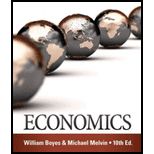
Economics:
10th Edition
ISBN: 9781285859460
Author: BOYES, William
Publisher: Cengage Learning
expand_more
expand_more
format_list_bulleted
Question
Chapter 26, Problem 13E
To determine
(a)
To explain:
The interdependence between the pricing strategies of firms A and B using the payoff matrix.
To determine
(b)
To compute:
The solution for the problems faced by the firms.
To determine
(c)
To explain:
The reasons for cooperation is mutually beneficial and the reasons for a firm can cheat.
Expert Solution & Answer
Trending nowThis is a popular solution!

Students have asked these similar questions
Suppose that Flashfry and Warmbreeze are the only two firms in a hypothetical market that produce and sell air fryers. The following payoff matrix gives profit scenarios for each company (in millions of dollars), depending on whether it chooses to set a high or low price for fryers.
Warmbreeze Pricing
High
Low
Flashfry Pricing
High
11, 11
2, 15
Low
15, 2
8, 8
For example, the lower-left cell shows that if Flashfry prices low and Warmbreeze prices high, Flashfry will earn a profit of $15 million, and Warmbreeze will earn a profit of $2 million. Assume this is a simultaneous game and that Flashfry and Warmbreeze are both profit-maximizing firms.
If Flashfry prices high, Warmbreeze will make more profit if it chooses a price, and if Flashfry prices low, Warmbreeze will make more profit if it chooses a price.
If Warmbreeze prices high, Flashfry will make more profit if it chooses a price, and if Warmbreeze prices low, Flashfry will make more profit if…
Refer to the normal-form game of price competition in the payoff matrix below
Firm B
Low Price
High Price
Firm A
Low Price
0, 0
50, −10
High Price
−10, 50
20, 20
Suppose the game is infinitely repeated, and the interest rate is 20 percent. Both firms agree to charge a high price, provided no player has charged a low price in the past. This collusive outcome will be implemented with a trigger strategy that states that if any firm cheats, then the agreement is no longer valid, and each firm may make independent decisions. Will the trigger strategy be effective in implementing the collusive agreement? Please explain and show all necessary calculations.
What is the difference between collusion and competition?
Group of answer choices
1-Competition is when firms operate independently. Collusion is when firms in the oligopoly market structure try to invite new entrants into the market to make it more competitive.
2-Collusion is when firms act together in ways to reduce output, keep prices high, and divide up markets. Competition is when firms operate independently.
3-Competition firms follow the price changes and product changes of the dominant firm in an oligopolistic market. Collusion is when firms operate independently.
4-Collusion is when firms follow the price changes and product changes of the dominant firm in an oligopolistic market.Competition is when firms operate independently.
Knowledge Booster
Similar questions
- The only two firms in a market are trying to decide what price to charge. The payoff matrix for this duopoly game is shown below. The payoffs are thousands of dollars of economic profit. In the Nash equilibrium, A). Firm A and Firm B are both making $80,000 in economic profit. B). Firm A and Firm B are both making $75,000 in economic profit. C). Firm A is making $80,000 and Firm B is making $75,000 in economic profit. D). Firm A and Firm B are both making $60,000 in economic profit.arrow_forwardConsider the following Cournot model. The inverse demand function is given by p = 30 –Q, where Q = q1 + q2. Firm 1’s marginal cost is $6 (c1 = 6). Firm 2 uses a new technology so that its marginal cost is $3 (c2 = 3). There is no fixed cost. The two firms choose their quantities simultaneously and compete only once. (So it’s a one-shot simultaneous game.) Answer the following questions. Derive Firm 1 and Firm 2’s reaction functions, respectively. Solve the Nash equilibrium (q1N, q2N). What is the equilibrium price and what is the profitl evel for each firm? Suppose there is a market for the technology used by Firm 2. What is the highest price that Firm 1 is willing to pay for this new technology? Now let’s change the setup from Cournot competition to Bertrand competition, while maintaining all other assumptions. What is the equilibrium price? Suppose the two firms engage in Bertrand competition. What is the highest price that Firm 1 is willing to pay for the new…arrow_forwardConsider a simultaneous move game with two players. Player 1 has three possible actions (A, B, or C) and Player 2 has two possible actions (D or E.) In the payoff matrix below, each cell contains the payoff for Player 1 followed by the payoff for Player 2. Identify any dominated strategies in this game. If there are none, state this clearly.arrow_forward
Recommended textbooks for you

 Exploring EconomicsEconomicsISBN:9781544336329Author:Robert L. SextonPublisher:SAGE Publications, Inc
Exploring EconomicsEconomicsISBN:9781544336329Author:Robert L. SextonPublisher:SAGE Publications, Inc Managerial Economics: A Problem Solving ApproachEconomicsISBN:9781337106665Author:Luke M. Froeb, Brian T. McCann, Michael R. Ward, Mike ShorPublisher:Cengage Learning
Managerial Economics: A Problem Solving ApproachEconomicsISBN:9781337106665Author:Luke M. Froeb, Brian T. McCann, Michael R. Ward, Mike ShorPublisher:Cengage Learning




Exploring Economics
Economics
ISBN:9781544336329
Author:Robert L. Sexton
Publisher:SAGE Publications, Inc

Managerial Economics: A Problem Solving Approach
Economics
ISBN:9781337106665
Author:Luke M. Froeb, Brian T. McCann, Michael R. Ward, Mike Shor
Publisher:Cengage Learning


